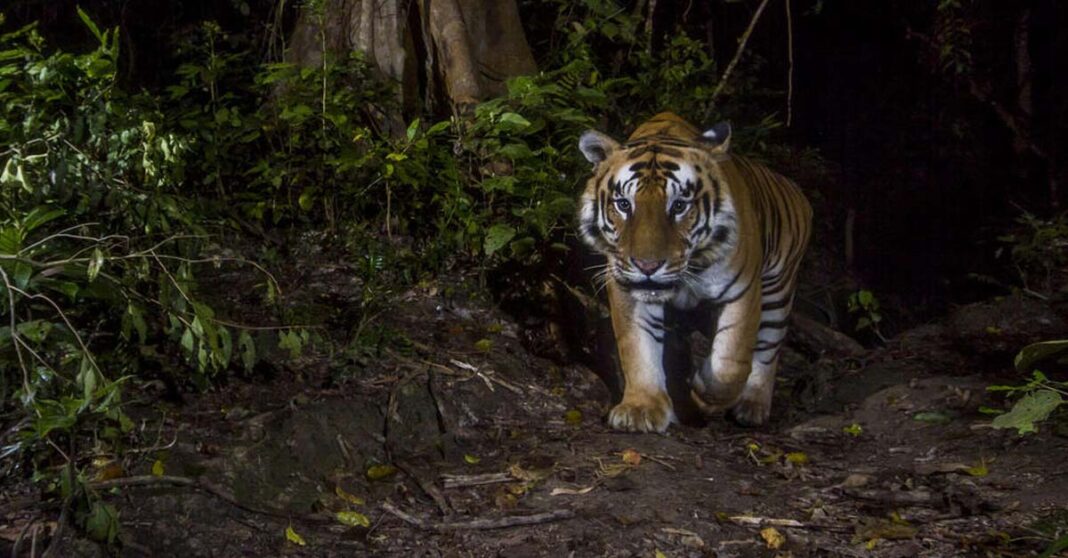On Global Tiger Day, while the world celebrates a global increase in wild tiger numbers and hard-earned recovery milestones by South Asian countries, Laos can look toward a more prominent role in future global tiger conservation efforts.
As a tiger range state member and contributor to the Southeast Asia Tiger Recovery Plan (STRAP), Laos has the opportunity to aid the much-needed recovery of tigers within the country and across Southeast Asia, where their numbers continue to dwindle.
With no hard evidence of tigers in Laos since 2013, when a tiger was last documented by camera traps in Nam Et Phou Louey National Protected Area in the east of the country, it may be time to turn to the west, closer to existing dispersing tigers and breeding populations for achieving tiger recovery.
With global tiger conservation targets looking to address the ongoing fragmentation of tiger habitats and the need to expand the tiger’s range, Laos, with ample tiger habitat remaining, holds excellent potential to aid the dispersal of tigers and bolster global recovery efforts.
In the years ahead, WWF and the Government of Laos commit to reducing existing threats to tigers across Laos’ threatened landscapes, addressing remaining challenges that stop tigers from taking up residence and breeding once more in the forests of Laos, and fostering connectivity between neighboring habitats.
“Lao has recognized and supports priority actions outlined in the Kuala Lumpur Joint Statement On Tiger Conservation, in particular to commit to support the implementation of actions within the STRAP and strengthen tiger populations in potential tiger habitats within South East Asia.
Laos has a key role to play on tiger recovery with strong national policy to increase forest cover up to 70%, we show commitment to support the conservation of biodiversity, including tigers, in Laos,” said Mr. Thongphath Vongmany Deputy Minister of the Ministry of Agriculture and Forestry.
One of the most immediate threats across potential sites where tigers could return to is snaring mostly to supply the illegal wildlife trade. At least 12.3 million snares are estimated as present in the protected areas of Laos, Cambodia and Vietnam. They kill indiscriminately, and impact over 700 terrestrial species from those as small as rats to those as large as elephants.
Snares not only decimate tiger populations but also deplete prey species, disrupting the long-term ecological integrity of habitats, and the services shared to the thousands of people across Laos. Without healthy ecosystems, both people and tigers cannot persist.
Recovering tigers not only benefits forest ecosystems and biodiversity in Laos, it also helps local communities. As top predators, wild tigers play an important role in maintaining the balance of the country’s ecosystems, safeguarding the nature-based livelihoods of Lao people, 67 percent of whom directly depend on forests for their day-to-day needs.
By preying on herbivores, tigers also help to maintain the stability of prey species, serving as an indicator of a healthy, thriving ecosystem, benefiting not only tigers but all lives that rely on their habitats.
WWF-Laos has been supporting the Government of Lao PDR to conduct applied conservation for more than two decades, much of this in Nam Poui National Protected Area, once a home for tigers, spanning 1,900k in the west of Laos. Not only is Nam Poui a key stronghold for Asian elephants in Laos, but it also holds the greatest potential for tiger recovery in the country.
It has promising numbers of prey species, there are reports from local communities of occasional tiger sightings, there is effective connectivity to breeding populations of tigers in Thailand, and additional protection offered by protected areas across the Thai border further to the west.
“As tiger range states and conservationists prepare for the next Global Tiger Recovery Period 2023-2034, Laos’ support for priority actions combined with sustained commitment from partners and increased investments and resources, the tiger’s roar could once again return to Laos.” said Chris Hallam, Conservation Director of WWF-Laos.
WWF-Laos is committed to supporting the government of Laos’ efforts to bring back the roar of tigers to the forests of Laos, working towards a future in which these iconic predators thrive and coexist with the Lao people for the benefit of sustainable development and planetary health.



